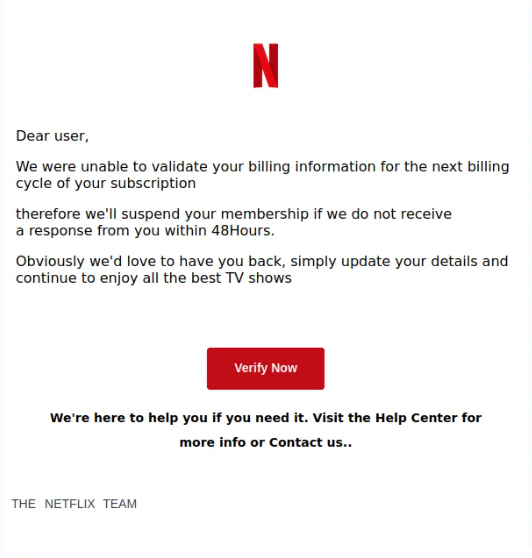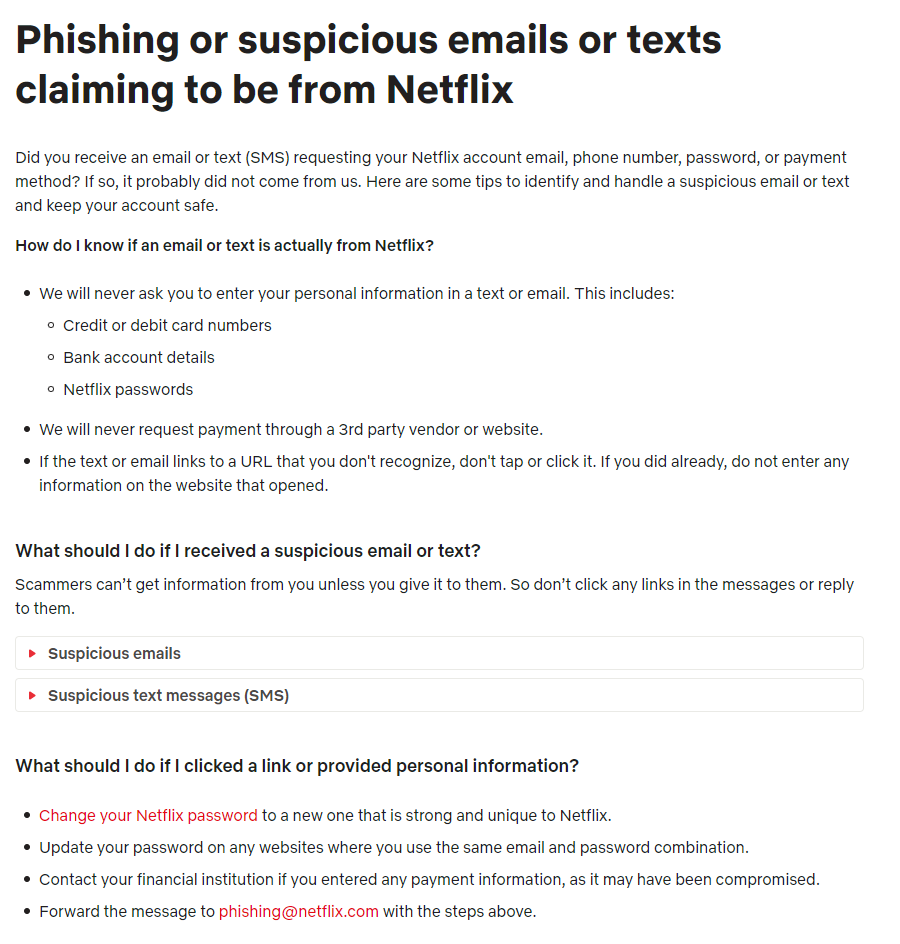Netflix We’ve Suspended Your Membership email is a phishing attempt that tries to steal your Netflix login credentials. The email claims that your Netflix account has been suspended because there were issues with your payment. It asks you to click on the provided link and update your details. However, because this is a phishing campaign, instead of updating your Netflix billing information, you’d be giving away your sensitive information to malicious actors.
Netflix We’ve Suspended Your Membership phishing email claims that you will no longer be able to stream Netflix content if you do not update your payment details. The email contains a link that would take you to a site imitating Netflix’s legitimate one. It would closely resemble Netflix’s login page but the URL would be different. And the URL would immediately give away the scheme if users pay enough attention to notice it.
If you try to log in to the fake Netflix site, your credentials would be sent to malicious actors operating this phishing email. Some scams may even go as far as to fake a login and then ask you to type your payment card information. Successfully phished information would either be used by the scam operators or sold to other cybercriminals on hacker forums. Either way, if you get phished, you would not only lose your access to your Netflix account but also potentially suffer financial loss.
Dear user,
We were unable to validate your billing information for the next billing cycle of your subscription
therefore we’ll suspend your membership if we do not receive a response from you within 48Hours.
Obviously we’d love to have you back, ismply update your details and continue to enjoy all the best TV shows.
Verify Now
We’re here to help you if you need it. Visit the Help Center for more info or Contact us..
THE NETFLIX TEAM
The above is just one example of a Netflix phishing email. Netflix accounts are a hot commodity so phishing emails are very common. It goes without saying that Netflix has nothing to do with these scams.
Unless you are targeted specifically by some malicious actor, the phishing emails you receive will be quite generic, which will make them easy to identify. We recommend you take the time to learn how to recognize such emails to avoid becoming a victim in the future.
How to recognize phishing emails
Malicious or phishing emails are often not difficult to identify. It’s mostly because malicious actors put very little effort into them.
If you use Netflix, you’ve probably noticed that all of their emails to you address you by name. Or more specifically, by the primary profile name. That holds true for all Netflix emails, including those notifying you about new logins, password changes, issues with payment, etc. Companies try to avoid using generic words like “Customer”, “User”, “Member”, etc. because they make the email seem impersonal. Malicious emails, on the other hand, use these generic words because they target a large number of users at a time and do not have access to their personal information. Even in the above Netflix phishing email example, the word “user” is used to address the recipient. In this particular case, this is a clear indication that the email is not sent by Netflix.
Malicious emails frequently contain spelling and grammar errors as well. Because malicious actors often do not speak good English, mistakes are very common. It goes without saying that you will never see glaring grammar/spelling errors in emails from trustworthy senders because they would appear incredibly unprofessional. In the above-displayed image of a Netflix phishing email, mistakes are very obvious. The lack of commas and full stops is particularly obvious.
Additionally, the senders’ email addresses can also reveal a lot about whether they are trustworthy or malicious. In many cases, emails are sent from random-looking email addresses, and it’s immediately obvious the emails are either malicious or at least spam. Random-looking email addresses (e.g. made up of random letters and numbers) look very unprofessional so companies will avoid them.
In general, clicking on links in emails is not a good idea. If you receive an email asking you to click on a link in order to make changes to your account, you should access the account manually rather than clicking on the link. Additionally, if you hover your mouse over a link in an email, the website’s URL will show up at the bottom. Do not click on any questionable-looking links or ones you do not recognize.
Finally, always check the website’s URL before logging in anywhere. Remember that while malicious actors can make their phishing sites look very real, the URL will always give it away. URLs need to be carefully examined since malicious actors employ a number of strategies to make them appear more trustworthy. For instance, the “r” and “n” letters combined together (“rn”) can first be mistaken for the letter “m”.
Remove Netflix We’ve Suspended Your Membership phishing email
If you ever receive a Netflix We’ve Suspended Your Membership phishing email, you can just delete it from your inbox. As long as you don’t interact with such emails, they are not dangerous. If you have interacted with a phishing email and entered your login information, you need to change your Netflix password right away if you want to continue using your account. For accounts such as Netflix, even when they hijack an account, malicious actors may not immediately change the login information in order to stop the account owner from realizing what has happened. If the account owner continues paying for the account, malicious actors can use the account themselves or sell it to someone else. When changing your Netflix password, make sure to check the box that would disconnect all linked devices.
If you can no longer access your Netflix account, try contacting Netflix to see whether it’s possible to get it back. If you cannot, contact your bank to cancel the card linked to your account in order to avoid being charged for something you can no longer use.

